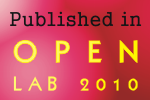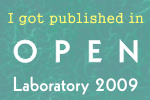Some interesting events cropped up recently. The Marco Island Advances in Genome Biology and Technology meeting was heavily tweeted and blogged about. Pacific Biosciences unveiled their third generation sequencer. Ostensibly, it can sequence reads of 20,000 length, but the fraction of actual long reads in a run, and their quality is still a bit hazy. […]
If the title of this post makes you cringe, then you belong to a minority of people who realize why the phrase “highly evolved” is so wrong. Unfortunately, “highly evolved” (as an absolute term) and “more evolved” (as a comparative term) seem to be used all-too frequently. They are uttered not only by non-scientists and […]
A small spike on my blog traffic yesterday led me to look for the source via Google Analytics. (If you are a blogger, you should really use this tool, lots of useful traffic information.) Seems like most of the traffic came from the page of a high school science teacher at Badin High School in […]
After hearing Jonathan Eisen and Nikos Kyripdes talk about GEBA in various meetings, it is great to see the paper finally come out, and under a CC license too. Good move for everyone. GEBA is the Genomic Encyclopedia of Bacteria and Archaea. The idea is simple: we have >1000 prokaryotic genomes in GenBank as of […]
The first bioinformatics meeting I went to was in 1996 at the Nachsholim resort, north of Tel Aviv. I received a fellowship for the duration, and shared a room with the brilliant Golan Yona, then a grad student at the Hebrew University. I was doing biochemistry at the time and knew next to nothing about […]
Stephen Colbert had an interesting lineup for the past two nights: Richard Dawkins on Sep 30, and Francis Collins last night. Enjoy the vids: The Colbert Report Mon – Thurs 11:30pm / 10:30c
First, a short glossary. Homologous genes are descended from a common ancestral gene. There are two types of homology: Orthology is homology due to a speciation event. So if there is a gene A’ in humans and A” in mice, and they are obviously similar in sequence, we infer that they homologous. We usually also […]
I ranted in a previous post about the use of homology as a quantitative term, rather than a qualitative term. Ben Blackburne commented on that post introducing me to “micro homology”, a term I did not know existed. I ignored its existence, until I heard it spoken yesterday at a talk, which sort of rubbed […]
Quorum sensing Social behavior is not exactly the first term that comes to mind with relation to microbes. After all, we assume a certain amount of intelligence and an ability to implement a behavioral pattern in response to peer actions. Humans, yes. Apes, yes. Birds of a feather flock together… so birds, yes. Ants and […]
UPDATE: I submitted this post to the National Evolutionary Synthesis Center’s sponsored contest for a travel award to ScienceOnline2010. Let’s see how it goes… #scio10 In a previous post about Hatena we saw what might very well be the beginning of a (beautiful?) [:ttip=”symbiosis where one partner lives inside the cell of the other” id=”10″]endosymbiotic[:/ttip] […]
(Thanks to F.B. for the inspiration). Sigh… people don’t seem to learn. It’s been almost 22 years (yikes!) since a distinguished group of scientists published a letter in Cell calling for a responsible use of the word “homology”. If you were born when that letter was published, then in the US you can already drink […]
In the Hatena story about symbiosis, I posted the following picture drawn by Ernst Haeckel: Beautiful! In this day and age of imaging, high resolution photography, and molecular graphics, we forget that scientific drawing was a skill as necessary to life scientists as microscopic imaging, or molecular graphics is today. Indeed, biology was very much […]
The story of a predator that, upon eating a certain food, suddenly becomes a peaceful plant. Sort of. Free-living versus symbiotic A working definition for symbiosis is two or more species that live and interact. Mutualism means that each derives a certain benefit from the other, or at most causing no harm to each other. […]





